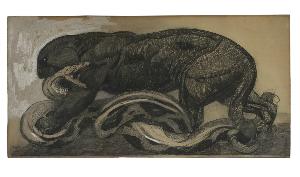Pierre-Paul Jouve
Pierre-Paul Jouve;Paul Jouve
Place: Marlotte
Born: 1878
Death: 1973
Biography:
Pierre-Paul Jouve was a French painter, sculptor, and illustrator born in Marlotte, France in 1878 and died in Paris in 1973. He is notable for his paintings and sculptures of Africa's animals. Jouve was the first recipient of the Prix Abd-el-Tif in 1907 and later of the Prix d'Indochine in 1921.
Early Life and Career
Jouve grew up in an artistic environment, as his father was a ceramist. He developed a passion for drawing and animals at an early age, and his father encouraged him to pursue his artistic interests. Jouve was particularly drawn to big cats and made them the subject of many of his works.
Notable Works and Awards
In 1907, Jouve was awarded a scholarship from the General Government of Algeria, and he became the first resident of Villa Abd-el-Tif in Algiers. He was also commissioned to create a frieze of wild animals for the Universal Exhibition of 1900. Jouve's work can be found in public collections in the United States, including the Metropolitan Museum of Art and the Museum of Modern Art in New York. Pierre-Paul Jouve was also known for his illustrations, and he was commissioned to illustrate Rudyard Kipling's Jungle Book. He was also awarded the Prix d'Indochine in 1921 for his work.
Travel and Inspiration
In 1922, Jouve traveled to the Far East, visiting Indochina, China, Ceylon, and India. He brought back hundreds of studies from this trip, which he used to illustrate Le Pellerin d'Angkor by Pierre Loti.
- Visit Pierre-Paul Jouve on Wikioo.org to learn more about his life and work.
- See Pierre Bonnard's paintings, such as Man and Woman, on Wikioo.org.
- Read about Paul Jouve on Wikipedia: Pierre-Paul Jouve
Jouve's work is a testament to his passion for African animals and his skill as a painter, sculptor, and illustrator. His legacy can be seen in the many public collections that feature his work, including the Metropolitan Museum of Art and the Museum of Modern Art.

